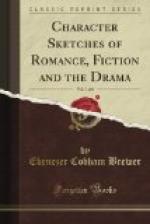ANAC’REON, the prince of erotic and bacchanalian poets, insomuch that songs on these subjects are still called Anacreon’tic (B.C. 563-478).
Anacreon of Painters, Francesco Albano or Alba’ni (1578-1660).
Anacreon of the Guillotine, Bertrand Barere de Vieuzac (1755-1841).
Anacreon of the Temple, Guillaume Amfrye, abbe de Chaulieu (1639-1720).
Anacreon of the Twelfth Century, Walter Mapes, “The Jovial Toper.” His famous drinking song, “Meum est prepositum ...” has been translated by Leigh Hunt (1150-1196).
The French Anacreon. 1. Pontus de Thiard, one of the “Pleiad poets” (1521-1605). 2. P. Laujon, perpetual president of the Caveau Moderne, a Paris club, noted for its good dinners, but every member was of necessity a poet (1727-1811).
The Persian Anacreon, Mahommed Hafiz. The collection of his poems is called The Divan (1310-1389).
The Sicilian Anacreon, Giovanni Meli (1740-1815).
ANACREON MOORE, Thomas Moore of Dublin (1780-1852), poet, called “Anacreon,” from his translation of that Greek poet, and his own original anacreontic songs.
Described by Mahomet and Anacreon Moore.
Byron, Don Juan, i. 104.
ANAGNUS, Inchastity personified in The Purple Island, by Phineas Fletcher (canto vii.). He had four sons by Caro, named Maechus (adultery), Pornei’us (fornication), Acath’arus, and Asel’ges (lasciviousness), all of whom are fully described by the poet. In the battle of Mansoul (canto xi.) Anagnus is slain by Agnei’a (wifely chastity), the spouse of Encra’tes (temperance) and sister of Parthen’ia (maidenly chastity). (Greek, anagnos, “impure.”) (1633.)
ANAGRAMS.
CHARLES JAMES STUART (James I.). Claims Arthur’s Seat.
DAME ELEANOR DAVIES (prophetess in the reign of Charles I.). Never so mad a ladie.
HORATIO NELSON. Honor est a Nilo.
MARIE TOUCHET (mistress of Charles IX.). Je charme
tout (made by
Henri IV.).
Pilate’s question, QUID EST VERITAS? Est vir qui adest.
SIR ROGER CHARLES DOUGHTY TICHBORNE, BARONET. You
horrid butcher,
Orton, biggest rascal here.
A’NAH, granddaughter of Cain and sister of Aholiba’mah. Japhet loved her, but she had set her heart on the seraph Azaz’iel, who carried her off to another planet when the Flood came.—Byron, Heaven and Earth.
Anah and Aholibamah are very different characters: Anah is soft, gentle, and submissive; her sister is proud, imperious, and aspiring; the one loving in fear, the other in ambition. She fears that her love makes her “heart grow impious,” and that she worships the seraph rather than the Creator.—Ed. Lytton Bulwer (Lord Lytton).
ANAK OF PUBLISHERS, so John Murray was called by lord Byron (1778-1843).




